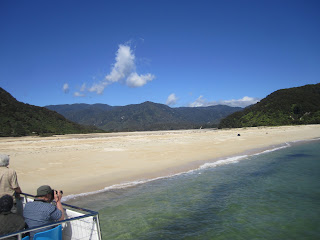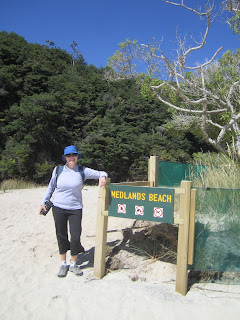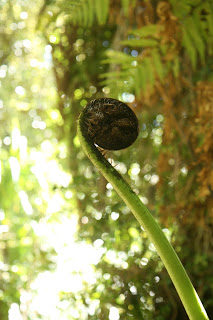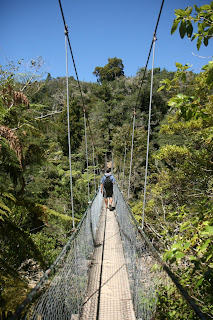Abel Tasman national park, in the northwest of the South Island, is possibly the most well-known park in New Zealand after Rotorua. It's a coastal park with a gorgeous, perfectly-maintained hiking/walking trail near the seashore, punctuated by huts, campsites and fancier lodges. The rocky shore is regularly interrupted by long, sandy beaches, making overnight sea kayak trips easy and popular.
(Abel Tasman was a dutch explorer who arrived in New Zealand and encountered the Maori nearly 130 years before Captain Cook. Also the namesake of the Tasman Sea between Australia and New Zealand, and Tasmania. Hats off to Captain Tasman!)
So think of it as a shorter, easier, very friendly and less dangerous version of the West Coast Trail and/or the Broken Group Islands in British Columbia.
For poorly equipped (and poor) travellers like us, a day trip was the best way to go. We got a boat ride along nearly the entire length of the park, then were dropped off in the middle for a few hours of walking along the coastal track, and were picked up again later on for a ride out. The weather could not have been better.
Our aquatic chariot, equipped for frequent shore landings.
Looking touristy, but with a whiff of intense outdoors capability? I wish.
Split Apple Rock.
These dead trees look a lot like mountain pine beetle victims in BC. In fact, these are non-native tree species that have been purposefully poisoned because they're in a national park. That's a nice project, but I experienced a lot of cognitive dissonance seeing this contrasted with hundreds of square kilometres of non-native tree farms right next door to this national park, with not a single native tree in sight. (But I won't bore you with my layperson's thoughts on forestry at this point.)
Coastal caves/arches.
Right in the center are mom and pup seals. There are many such fur seals in the park. Talk about crappy luck to have humans call your species "fur seals" - that does NOT bode well for your survival, though they're doing well enough these days.
Lots of beaches between sections of rocky shore. The water is a bit greener than in Australia, probably because it is colder and contains more nutrients (plankton and the like).
Many long estuaries lie behind the beaches.
Our dropoff point.
Including detours, probably a bit more than 13 km without much uphill to Anchorage - a nice easy walk.
Standard unstable New Zealand slope on the trail. Carry on.
Lots of ferns in New Zealand, and they are much hardier and can survive in a wider variety of environments than the types we have back in BC.
This fiddlehead was about 7 feet tall.
The ferns start off looking like small collections of plants - but then they grow into full-on palm trees! Quite skookum.
This stream-fed pool on the trail is over 6 feet deep. Very clear, and a popular spot for a dip.
At about the halfway point, we came to a little settlement of several homes and cabins, clearly grandfathered before the area was made a national park. It would be great to have one of those places in the family!
We had lunch on the estuary beside the settlement. The tide had come in far enough that we took the long way around the edge rather than cutting across the sand that was rapidly being covered by water.
Extremely clear streams seemed to occupy every ravine.
Cleopatra's Pool was a short detour, but well worth it. Crystal clear (and cold) fresh water, perfect for a quick dip.
 |
| Calvin Klein is not exactly beating down my door |
After a lovely afternoon on a smooth trail (though be warned it would be pretty muddy after a rain) in the mid-20s C, we arrived at Anchorage and another lovely beach and a refreshing swim, this time in salt water.
After the return boat trip, we wended our way through endless kilometres of extremely tight curves up and over a pass to the Golden Bay area west of Abel Tasman, and the hippie town of Takaka. Again I was very much reminded of the Shuswap hippie farm areas back home. We blasted through Takaka and made a beeline for Onekaka and the iconic Mussel Inn, a famous, earthy craft beer establishment.
Tasters on the patio, including their well-known "Captain Cooker" manuka beer. The manuka is a native tree - manuka honey is very expensive, and is sold as a (somewhat snake-oil-like) health food product/homeopathic medicine, rather than a food. This beer contains part of the manuka tree which is rich in vitamin C - and apparently is what Captain Cook incorporated into beer in order to ward off scurvy among his crew, according to legend. But it does taste a lot like spruce tip beer, which has similar vitamin C content.
Unfortunately, the band wasn't scheduled to play that night.
The tree-covered, granola-esque environs of the beer garden.
We had heard about this - if you forget your cell phone at the Mussel Inn, you'd better hurry back within a couple of hours. If your phone remains unclaimed for longer than that, they nail it to a tree, right through the screen. No joke! Hippies with an agressive streak - yep, sounds like the Shuswap. :-)
We pulled into a convenient beachside holiday park near the Mussel Inn for the night. Where I settled in to re-reading The Hobbit for the first time since childhood, as the movie was shot in New Zealand and was still playing in theatres. (But oh, how painful to see that after-swim hair begging to be cut...)

































No comments:
Post a Comment